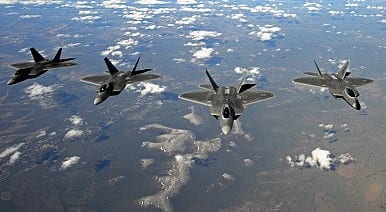 Photo Credit: U.S. Air Force
Photo Credit: U.S. Air Force
Press Release: Climate Change and the Continuing Risk to Military Infrastructure
Washington, DC – Today, President Trump is publicly assessing the damage from Hurricane Michael on a trip to the Florida panhandle. All elements of the U.S. government have grappled with this since October 10, when the record-setting storm made landfall. The storm swept across the Florida panhandle, devastating entire communities, including Tyndall Air Force Base. While the assessment is ongoing, the Air Force reports that, “The flight line is devastated. Every building has severe damage. Many buildings are a complete loss.” Most worryingly for America’s long-term security, there is an uncertain future for the 17 F-22s Raptor jets that were left on base in a hanger to weather the storm. These state-of-the-art stealth jets cost $339 million apiece – but are essentially priceless since the production line was shut down. Into the future, because of man-made climate change, severe storms like Hurricane Michael will become more likely. As climate change contributes to warmer oceans and higher sea levels, many of our military bases and stations will be at risk.
The American Security Project (ASP) has long analyzed the threat of climate change to our military infrastructure. Since its founding in 2006, ASP has argued that the “physical changes to the environment such as, flooding, drought, and extreme weather events may disrupt U.S. military capabilities and facilities.” Our readiness is clearly undermined without fully operational bases and stations. In 2012, ASP produced a report on some of the most vulnerable U.S. military bases around the globe. One of the most vulnerable was Eglin Air Force Base, just 80 miles from Tyndall Air Force Base. In 2018, ASP updated the analysis and created an interactive map to outline the range of threats to bases beyond sea level rise, including extreme drought and dangerous hurricanes.
The damage to Tyndall Air Force Base is tragic, but it’s only the beginning. Storms will continue to become more extreme and impact the ability of our armed forces to fight and win our nation’s wars. Assessing and addressing the threat of climate change is critical for the future viability of our force. For a full analysis of how climate change impacts military infrastructure, visit ASP’s homepage on Climate Change and U.S. Military Bases.
See more about how climate change will impact national security at www.americansecurityproject.org/climate-security.





